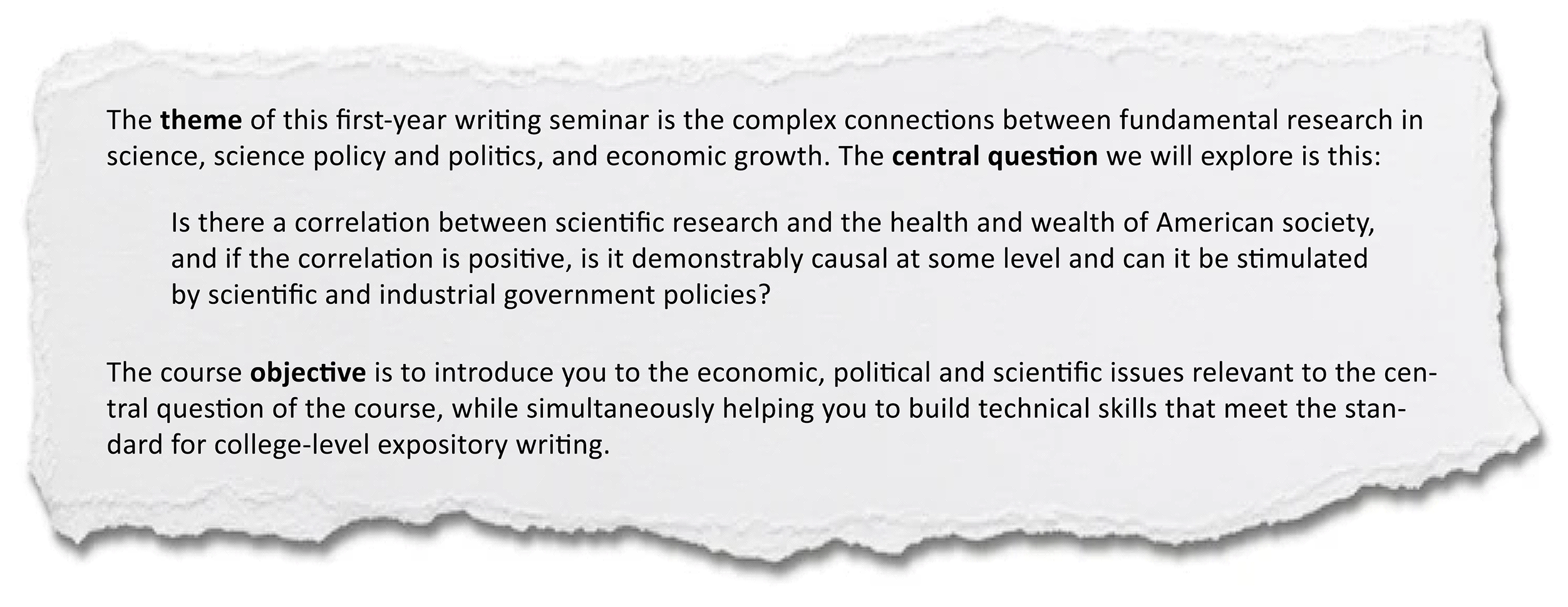one of these things was not like the others: experiences with standards- and specifications-based grading
 this guest blog post comes from richard f. haglund, stevenson professor of physics.
this guest blog post comes from richard f. haglund, stevenson professor of physics.
the following comments are reflections after a year of fruitful dialogue with colleagues in an on-line learning community sponsored by the 2022年世界杯中国小组赛积分, organized and led by cynthia brame. what i experienced about grading in 2020-2021 is a significant difference between standards-based grading – which is what i think i tried to do in a fall writing course – and mastery- or specifications- based grading, which is what i attempted to do in the spring introductory physics course.during the fall semester 2020, i taught a first-year writing seminar (phys 1111-05) devoted to “science, politics and economic growth” and, not incidentally, to writing about that three-way intersection. as posed in the syllabus:

view the schedule of lecture themes and writing assignments.
i have taught writing-heavy courses before and have used a standards-based set of grading criteria that i lifted from a former member of our english faculty. you can view the grading criteria here. in my mind, that standard captured the critical characteristics that distinguish well-argued, stylistically elegant writing from the merely adequate or pedestrian. when i retrieved that standard and revised it in august 2020, i hoped it would furnish a rational basis for explaining to my phys 1111 students why they were getting a grade of b rather than the a they would probably expect from their high-school preparation. more importantly, i had hoped it would serve the critical didactic purpose for a writing course by highlighting obvious features that students could use to critique their own writing.
but it did not work that way. even on the papers for which the students were assigned a temporary grade and given an opportunity to rewrite, they generally only moved text around and tinkered at the margins – but did not revise or rewrite substantially based on their own critique or my suggestions. of course, only rarely did essays merit a grade of c; these were vanderbilt students after all. and in those few cases, the revised version was good enough to get over the bar to a b or b-, usually by fixing mechanical errors rather than by measurably improving style or content. [the turnitin software in brightspace allowing detailed comparisons between original and revised versions made this a semi-quantitative exercise.] but it did not seem to matter much whether i graded their papers based on a point system whose sum dictated the letter grade, or more broadly based on a qualitative judgment about whether the papers seemed to fit the rubric for that letter grade.
at the end of the semester, only the strongest two or three of the fifteen students in the class had figured out how to write about the topics they chose for their final papers with the verve and impact that characterizes the best writing about science and society that one finds, for example, in the new yorker account of the history of the computer mouse or marianna mazzucato’s the entrepreneurial state, a required text for the course. reading their final papers, i felt that most of the students had not discovered writing as a skill to apply to learning about and addressing a critical question but saw it simply as academic exercise – another hurdle to clear or knock over on the way to the finish line.
fresh from the disheartening realization that the standards-based grading strategy had failed, i turned in january to teaching the second semester of our introductory course for prospective physics majors (phys 1912) – a course i had not taught in more than a decade. in search of a better way both to teach and to evaluate, i read much of linda nilson’s specifications grading as i prepared the syllabus and thought about course objectives and grading strategy. view the syllabus for phys 1912 here. in putting together the syllabus, i thought the intersection of concept mastery and skill development (e.g.., mathematical and computational methods).
problem-solving exercises, both analytical and computational, are the time-honored route to building the skills needed to meet the ambitious objectives for the course. i decided not to grade the homework in detail but rather to post the solutions after the deadline and let students revise and resubmit as needed. this effectively meant that no student needed to think that their final grade would depend critically on work done on deadline and under pressure. moreover, the students were encouraged to work together on the problem sets and to communicate via discussion threads in brightspace. to my delight, even in the mandated on- line environment of the spring semester, groups of students found ways to learn together through attacking the substantial problem sets.
the two mid-term examinations were graded in a similar way: the solutions were evaluated based on the degree of mastery demonstrated. anyone who was dissatisfied with their grade was invited to write a self-evaluation indicating where their approach had failed and how they needed to adjust their approach either to studying or problem-solving. extra points were added to the initial raw score based on the thoroughness of that analysis.
rather than give a final examination, i assigned a final project – format to be chosen by the student – in which they were asked to demonstrate mastery of the objectives contained in the syllabus. the projects ranged from term papers – on the electrodynamics of the touch-screen display, for example – to a web-based tutorial on the complicated plasma physics of fusion reactors. there were computational physics studies that were more ambitious than i would have dared to assign – such as a simulation of the aurora borealis based on the interaction of the solar wind with the upper atmosphere.
i am now rebuilding the syllabus for this fall’s offering of the writing course based on what i learned from trying to apply the techniques of specifications grading in the spring, including:
- incorporating an element of peer collaboration on writing
- instituting a feedback or editorial mechanism as students develop essay themes
- emphasizing the idea of “writing to learn” in the required discussions of writing skills
- discussing ways to lay the groundwork for successful development of an essay
- demonstrating how precise vocabulary and structural economy determine impact
- building classroom exercises in which writing style and vocabulary are analyzed
for the writing course, the biggest challenge i foresee is how best to help students learn what strunk and white called “the elements of style.” mastering maxwell’s equations seems easier!
.
.
.
.
.
.
.

leave a response